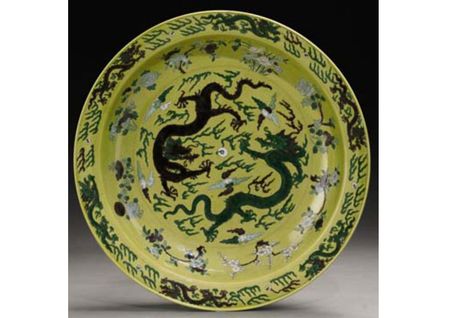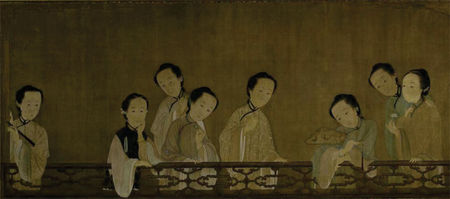Sotheby’s Asia Week Sales Commence with Fine Chinese Ceramics and Works of Art
A Rare ‘ Famille-Rose’ ‘Boys at Play’ Lantern-Shaped Vase, Qianlong Iron-Red Seal Mark and Period, Property of Gordon Getty, est. $300/500,000. Photo: Sotheby´s.
NEW YORK, NY.- Sotheby’s March 17th sale of Fine Chinese Ceramics and Works of Art in New York will feature a tightly-curated selection of ceramics, paintings, and sculpture of the highest quality, from a number of distinguished American private collections. Included will be superb lots from The Gordon Getty Collection, among them three pieces of fine Qianlong mark and period porcelain and a remarkable and highly unusual ‘Figures and Landscape’ automaton. Property from the sale, which is expected to bring in excess of $4 million, will be on view beginning March 13th.
Property of Gordon Getty
Highlighting the Spring sale are four lots consigned by Gordon Getty, including a rare ‘Famille-Rose’ ‘Boys at Play’ lantern-shaped vase, Qianlong iron-red seal mark and period (est. $300/500,000). The charming depiction of multiple boys at play in a garden (representing the wish for many sons) was a popular theme in the decorative arts of the Ming and Qing dynasties. In this vase, each boy is engaged in an activity potent with symbolism: the boy flying a kite is meant to wish one a ‘rise in rank’ and a successful career; the one holding a lotus refers to ‘may my descendents live in harmony’; and the boy with the vase (ping) is a pun for peace. Although Qianlong period vases featuring this motif can be found in several important collections, this vase appears to be distinctive in its combination of the oviform and waistedneck silhouette, ruby-ground palette and use of sgraffiato (incised design).
A rare pair of ‘Famille- Rose’ ‘Eight Daoist Immortals’ jars and covers, Qianlong iron-red seal marks and period. est. $300/400,000. Photo: Sotheby´s.
Another featured Getty property is a rare pair of ‘Famille- Rose’ ‘Eight Daoist Immortals’ jars and covers, Qianlong iron-red seal marks and period (est. $300/400,000). The jars are exquisitely painted around the cylindrical body with the ‘Eight Daoist Immortals Crossing the Sea’ after attending the peach festival of the Queen Mother of the West. They ride the rough waves on their respective vehicles, each holding an attribute, with some standing in a windswept stance. Rather than traveling by their clouds, they combined their powers to sail past the tempest – a lesson on how individual strengths and gifts can be used to tackle a common obstacle.
A rare and large ‘Figures and Landscape’ automaton, Qing Dynasty, 19th century. est. $250/350,000. Photo: Sotheby´s.
The rare and large ‘Figures and Landscape’ automaton, Qing Dynasty, 19th century is another Getty property (est. $250/350,000). This spectacular work, which has its roots in the clockmaking tradition, is extremely rare. When the Jesuit Matteo Ricci introduced two striking clocks to the Wanli emperor in 1601, it sparked a fascination with mechanical marvels that continued into the reigns of the Qing dynasty rulers. A palace workshop focused on the production of western-style clocks, where automata were created and conceived by Jesuit missionaries. In the present work, left, the large central glass case, flanked by two smaller cases, depicts a lush mystical mountain setting with pavilions, bridges and a pagoda, enshrouded by long horizontal clouds. The central case is electrically wired, and when activated its components spring to life. In the center, a seated figure in the act of writing displays his quill as it navigates the scroll, an attendant kowtowing near his feet. Nearby a red butterfly flutters to and fro, and a warrior flies defiantly in mid-air. On the lower section, a group of Immortals skim the white capped surface of the sea where a mythical sea-monster raises its head, and a mouse scurries near the water. In the two adjacent cases, figures are situated among foot paths and pavilions. The entire landscape is dotted with extremely rare kingfisher feather ornaments, comprised of papier-mâché, silk, wire and polychrome paint.
A finely-carved and large pale celadon marriage bowl, Qing Dynasty, Qianlong period. est. $400/600,000. Photo: Sotheby´s.
The auction will also feature a finely-carved and large pale celadon marriage bowl, Qing Dynasty, Qianlong period (est. $400/600,000), formerly in the Collection of R. H. R. Palmer. Marriage bowls were popular during the Qing period, and the large size of the present work makes it very rare. Such bowls are often decorated with auspicious symbols, as seen here: The interior is carved with a lively grouping of two peaches and a fluttering bat; the reverse features the ‘Eight Buddhist Emblems’ and ‘Double Happiness’ characters and a pair of handles in the form of dramatically reticulated open-winged bats. Peaches and bats together represent a blessing of longevity, and a pair of bats symbolizes a wish for double blessings. The ‘Eight Buddhist Emblems’ characters on the exterior and the traditional wedding motif of ‘Double Happiness’ reinforce the blessing bestowed upon the recipient of this grand jade bowl.
An extremely rare and magnificent blue-splashed ‘Sancai’ pottery money chest, Tang Dynasty. est. $80/100,000. Photo: Sotheby´s.
An extremely rare and magnificent blue-splashed ‘Sancai’ pottery money chest, Tang Dynasty (est. $80/100,000) from an important East Asian Collection is another sale highlight. Models of money chests, which would have been secured with a padlock, have been found in several Tang tombs, but are otherwise extremely scarce. The various extant chests differ in their applied ornaments and in glaze colors, and come in two sizes. Whereas the use of cobalt-blue is generally found only on the smaller size, the present piece belongs to the larger type and is particularly richly adorned.
A fine pair of ‘Doucai’ conical bowls, Yongzheng marks and period. est. $120/150,000. Photo: Sotheby´s.
From the Collection of Doctor and Madame Ho-Ching Yang, a fine pair of ‘Doucai’ conical bowls, Yongzheng marks and period, (est. $120/150,000), are attractive for their very fine and thin potting and elegant conical shape with slightly rounded sides. The decoration in the doucai enamels is especially vibrant and is delicately painted in a very naturalistic fashion. The medallions, painted with flowering plants of the four seasons, are typical of the most successful Yongzheng period designs, and these bowls represent the best quality wares produced under the Yongzheng emperor’s tutelage, when porcelain enameling reached a new level of excellence during the early 18th century.
A large green and aubergine yellow-ground biscuit charger, Kangxi mark and period. est. $50/70,000. Photo: Sotheby´s.
Also featured is a large green and aubergine yellow-ground biscuit charger, Kangxi mark and period (est. $50/70,000). Kangxi mark and period chargers of this design are included in several museum and private collections, including the National Palace Museum, Taipei, the Palace Museum, Beijing, and the Victoria and Albert Museum, London. The present charger is a highlight of a large group from the Collection of Julius Morgenroth (1871-1924), and was on loan to the Miami University Art Museum, Ohio, and previously at the Akron Art Institute.
Another highlight is the Eight Beauties painting, ink and color on silk, signed Hua Xuan, with a cyclical date corresponding to 1736. A very rare painting of extravagantly large size – 230 by 52 inches – it is estimated to sell for $200/300,000. Photo: Sotheby´s.
Another highlight is the Eight Beauties painting, ink and color on silk, signed Hua Xuan, with a cyclical date corresponding to 1736. A very rare painting of extravagantly large size – 230 by 52 inches – it is estimated to sell for $200/300,000. It is unusual to find a group of women as the subject of a single Chinese painting. Each “beauty” holds an object representing a different virtue the woman in the center holds a finger citron, symbolizing long life. The painting was first published in a 1914 catalogue by the Shanghai dealer E. A. Strehlneek, who subsequently sold the painting to Herr Klas Fahraeu of Brevik, Stockholm. It is now in a private Boston collection.

/https%3A%2F%2Fprofilepics.canalblog.com%2Fprofilepics%2F1%2F0%2F100183.jpg)
/https%3A%2F%2Fstorage.canalblog.com%2F03%2F02%2F119589%2F96711876_o.jpg)
/https%3A%2F%2Fstorage.canalblog.com%2F11%2F31%2F119589%2F94773502_o.jpg)
/https%3A%2F%2Fstorage.canalblog.com%2F20%2F83%2F119589%2F94772815_o.jpg)
/https%3A%2F%2Fstorage.canalblog.com%2F26%2F72%2F119589%2F75604929_o.jpg)
/https%3A%2F%2Fstorage.canalblog.com%2F59%2F60%2F119589%2F26458628_o.jpg)










/http%3A%2F%2Fstorage.canalblog.com%2F91%2F48%2F119589%2F128923043_o.jpg)
/http%3A%2F%2Fstorage.canalblog.com%2F84%2F09%2F119589%2F128922928_o.jpg)
/http%3A%2F%2Fstorage.canalblog.com%2F74%2F57%2F119589%2F128709421_o.jpg)
/http%3A%2F%2Fstorage.canalblog.com%2F96%2F72%2F119589%2F128683141_o.jpg)